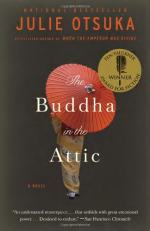|
This section contains 365 words (approx. 1 page at 400 words per page) |

|
The Buddha in the Attic Summary & Study Guide Description
The Buddha in the Attic Summary & Study Guide includes comprehensive information and analysis to help you understand the book. This study guide contains the following sections:
This detailed literature summary also contains Quotes and a Free Quiz on The Buddha in the Attic by Julie Otsuka.
The image of a laughing Buddha left behind in an attic symbolizes the experiences of several Japanese women and their families in early twentieth century America. The novel “The Buddha in the Attic” by Julie Otsuka follows the lives of a group of young women as they travel by boat to America. All are hoping for a better life. They work hard beside their husbands to make a place for themselves in America. After the bombing of Pearl Harbor, however, the American dream turns into a nightmare as the Japanese are forced to leave behind the things for which they have worked so hard. They are sent to live in interment camps.
The book is composed of eight different significant scenes in the lives of this group of women. They first travel to America by boat as picture wives. Their first disappointment comes when they arrive in America to learn that the husbands to whom they were promised were not the attractive, financially secure men they advertised themselves to be. A second scene of significance included in the novel is the women’s first night with their husbands.
A third chapter describes the treatment the Japanese receive from the white people for whom they work. A fourth and fifth chapter describe the numerous babies born to the Japanese women and the way these children try to fit into the American culture. The rumors that abound after the bombing of Pearl Harbor are the main focus of the book’s sixth chapter. Japanese men are arrested without notice and little cause and taken from their families. The chapter concludes with all people of Japanese descent being given orders to evacuate to interment camps.
The seventh chapter describes the variety of mindsets of the people and their children as they are forced to leave all of the things for which they have worked so hard. In the final chapter of the novel, the Americans react when they realize the Japanese people have disappeared from their town. Although they’d never really given the people much thought, they miss them now that they are gone and courser, less civilized people are taking their places.
Read more from the Study Guide
|
This section contains 365 words (approx. 1 page at 400 words per page) |

|



